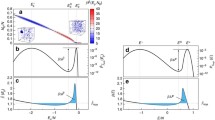Abstract
The results of computer simulations of monolayers created from monodisperse latex particles are presented and discussed. Layers are characterized by the normalized coverage,NC (the actual coverage of the surface related to its maximum possible coverage with particles), and by the average number of neighbors,ANN, calculated as the number of particles being in contact with a given one and averaged over all the particles on the surface. Variable parameters used in simulations include: the rate of particles deposition, the probability of lateral movements, the probability of desorption of particles adsorbed on the surface, the probability of covalent immobilization of adsorbed particles, and the “on-sphere slip” parameter, OSS (characterizing the scattering of a falling particle on the particles being already attached to the surface). Morphology of monolayers is qualitatively characterized by relations betweenANN andNC. It is shown that for all monolayers formed without adhesion (and without repulsion) between the particles adsorbed on the surface the dependence ofANN vs.NC is described by a characteristic master curve (regardless of the values of probabilities of desorption and lateral movements of particles). For the monolayers created including adhesive forces between the adsorbed particles the plots ofANN vs.NC lie above the master curve, while similar plots obtained for the layers made of particles showing various types of repulsive interactions are always placed below it. Thus, the dependencies ofANN vs.NC, derived from computer simulations, can be used for the determination of the character of the interparticle interactions in the real systems.
Similar content being viewed by others
References
Allen G, Bevington JC (eds) Comprehensive polymer science. Pergamon Press, Oxford, Vol 7
Roberts G (ed) (1990) Langmuir-Blodgett Films. Plenum Press, New York, pp 1–425
Stroeve P, Balazs AC (eds) (1992) Macromolecular Assemblies in Polymeric Systems. ACS Symp Ser 493, Washington, DC, pp 1–326
Takeda F, Matsumoto M, Takenaka T, Fujioshi Y (1981) J Colloid Interface Sci 84:220
Decher G, Eßler F, Hong JD, Lowack K, Schmitt J, Lvov Y (1993) ACS Polym Prep 34(1):745
Subirade M, Lebulge A (1994) Thin Solid Films 243:442
Cheng SS, Chittur KK, Sukenik CN, Culp LA, Lewandowska K (1994) J Colloid Interface Sci 162:136
Minehan DS, Marx KA, Tripathy SK (1994) Macromolecules 27:777
Peanasky J, Schneider HM, Granick S, Kessel CR (1995) Langmuir 11:953
Miwa T, Yamaki M, Yoshimura H, Ebina S, Nagayama K (1995) Langmuir 11:1711
Ugelstad J, Berge A, Ellingsen T, Schmid R, Nilsen TN, Mørk PC, Stenstad P, Hornes E, Olsvik O (1992) Progress Polym Sci 17:87
Guzman RZ, Carbonell RG, Kilpatrick K (1986) J Colloid Interface Sci 114:536
Vincent B, Young CA, Tadros ThF (1980) J Chem Soc Faraday Trans I 76:665
Kallay N, Tomic M, Biskup B, Kunjasic I, Matijevic E (1987) Colloids Surf 28:185
Dabroś T, van de Ven TGM (1987) Physico Chem Hydrodyn 8:161
Varennes S, van de Ven TGM (1987) Physico Chem Hydrodyn 9:537
Adamczyk Z, Siwek B, Zembala M, Warszynski P (1989) J Colloid Interface Sci 130:578
Schaaf P, Talbot J (1989) J Chem Phys 91:4401
Jullien R, Meakin P (1992) J Phys A 25:L189
Robinson DJ, Ernshaw JC (1993) Langmuir 9:1436
Adamczyk Z, Szyk L, Warszynski P (1993) Colloids Surf A 75:185
Adamczyk Z, Siwek B, Zembala M (1993) Colloids Surf A 76:115
Wojtaszcyk P, Schaaf P, Senger B, Zembala M, Voegel JC (1993) J Chem Phys 99:7198
Adamczyk Z, Siwek B, Szyk L (1995) J Colloid Interface Sci 174:130
Wojtaszczyk P, Mann EK, Senger B, Voegel JC, Schaaf P (1995) J Chem Phys 103:8285
Schaaf P, Wojtaszczyk P, Mann EK, Senger B, Voegel J-C, Bedeaux D (1995) J Chem Phys 102:5077
Mann EK, Wojtaszczyk P, Senger B, Voegel J-C, Schaaf P (1995) Europhys Lett 30:261
Adamczyk Z, Siwek B, Zembala M, Beloushek P (1994) Adv Colloid Interface Sci 48:151
Ulman A (1993) Adv Mater 5:55
Slomkowski S, Kowalczyk D, Trznadel M, Kryszewski M (1994) ACS Polym Prep 35(2):409
Freeman RG, Grabar KC, Allison KJ, Bright RM, Davis JA, Guthrie AP, Hommer MB, Jackson MA, Smith PC, Walter DG, Natan MJ (1995) Science 267:1629
Slomkowski S, Kowalczyk D, Trznadel M (1995) Trends Polym Sci 3:297
Grabar KC, Freeman RG, Hommer MB, Natan MJ (1995) Anal Chem 67:735
Dickinson E, Euston SR (1992) Adv Colloid Interface Sci 42:89
Author information
Authors and Affiliations
Rights and permissions
About this article
Cite this article
Trznadel, M., Slomkowski, S. Formation and morphology of latex monolayers. Computer simulation studies. Colloid Polym Sci 274, 1109–1118 (1996). https://doi.org/10.1007/BF00655681
Received:
Accepted:
Issue Date:
DOI: https://doi.org/10.1007/BF00655681



